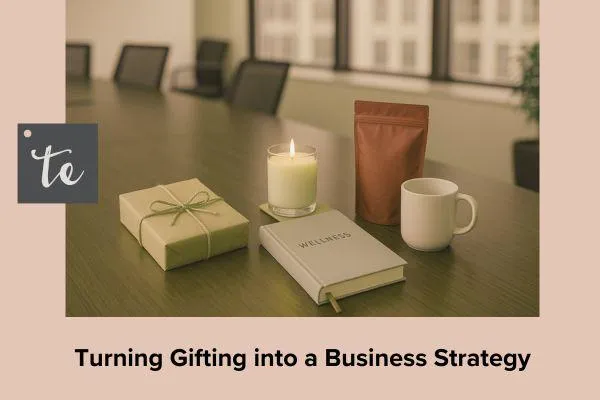

What Swimming Teaches Us About Team Relationships
In my latest video, I break down how swimming teaches us the importance of these relationship-building efforts and the specifics of what we as leaders need to nurture with our teams.
Holiday Gift Insights - What Everyone Else Is Doing
In an effort to simplify the decision-making process, we're sharing some of the trends we've seen with gifting over the years. We're even sharing our best seller and why that gift had such success.
What Makes A Successful Holiday Gift? The Travel Bag Edition
Last year we had the opportunity to work with one of our clients in the travel and tourism space to design an experience that delivered their highest engagement yet.

Turning Gifting into a Business Strategy
We’ve all experienced that moment where it suddenly occurs to us, “We should send something…”. And just like that, another round of last-minute gifts goes out the door with little more than a hope they’ll “land well.”
If you’ve ever wondered whether your gifting efforts are actually working, or if they could be doing more, you’re not alone. In fact:
36% of companies say they struggle to find gifts that truly make an impact.
31% want their gifts to help them stand out.
But only 28% have a real strategy behind what they’re sending.
That means the majority of businesses are spending money on gestures they hope are meaningful but aren’t sure.
And that’s where gifting strategy comes in.
The Real Barrier to Effective Gifting
When gifting is treated like a checklist item, it quickly becomes transactional. But impactful gifting, the kind that creates real emotional connection, requires intention.
At The Expressory, we ask - “What story is this gift telling?”
Without that story, a gift is just stuff. And nobody remembers stuff.
Here’s what we see all the time:
Gifts that are reactive
Gifts that are generic
Gifts that don’t make anyone feel seen or valued
And that’s where most businesses lose the chance to build emotional loyalty and any kind of lasting relationship with the recipient.
Our Definition of a Gift (Hint: It's Not the Item)
At The Expressory we see gifting as any intentional act of giving that shows you care, with no expectation of return.
It’s not about the product. It’s about how you make someone feel.
Why These Matter More Than Items
If the gift is meant to make the recipient feel something, the best approach is to make sure it has some kind of story. A theme is what gives that story structure. It’s what connects the dots between your intent and the recipient’s experience.
A theme transforms "things" into a thoughtful, relationship-building experience.
And yet, most companies skip this part completely.
Instead of “What’s a good gift we can send to everyone?”, the better question is:
“What message do we want to send to this person? And what can we send that reflects that message?”
How to Discover a Gift Theme
Before you can uncover a meaningful theme, you have to slow down and really look at who this gift is for and what’s going on in their world.
This part is where many well-meaning businesses go off track.
Instead of basing a gift on assumptions or generalizations, the foundation of strategic gifting is research. You’re trying to create an experience based on the uniqueness of the recipient. And the only way to do that well is to take the time to understand them.
Step 1: Prioritize the Relationships
Not every connection needs the same investment. Identify the categories of relationships that need attention now. This can be clients, strategic partners, or prospects.
Step 2: Research Your Contacts
Yes, real research.
You want to gather both qualitative and emotional insights. Look into:
What accomplishments, transitions, or milestones they’ve recently experienced
What values, causes, or interests they share publicly
The goals and challenges of their industry or even their company
Awards
Conferences or events they participate in
This isn’t about “what’s their favorite snack” (though fun details help!). It’s about building a real picture of who they are and where they are in their journey.
Step 3: Analyze for Themes
Once you’ve done the research on your priority contacts, it’s time to find the patterns.
Look through your notes for recurring values, goals, challenges, or even language. This is where common threads, your themes, start to emerge. These aren’t just surface-level preferences like “likes chocolate.” We’re talking about deeper signals, like:
A focus on building team culture
Anxiety around rapid growth
Passion for legacy-building
Desire for work-life balance
To make this process easier (and faster), we often recommend using AI to assist in spotting those emotional keywords and repeated concepts across your research notes. You can even ask tools like ChatGPT to identify common pain points or motivators and cite where they came from so you can validate what shows up most.
Once you identify those themes, they become your foundation. They’ll guide what you give and what you say, ensuring each touchpoint resonates with what truly matters to the recipient.
This isn’t just about being personal. It’s about being purposeful. When you take the time to understand what truly matters to someone and build your coorporate gifting strategy around that insight, the guesswork disappears. You're no longer hoping a gift will land. You’re creating a moment that’s guaranteed to resonate. And that’s when gifting becomes a tool for real relationship building and long-term loyalty.
What You Should Be Asking Yourself Now
Now that you’ve seen what’s possible when gifting becomes strategic, here are a few questions to help you reflect on where your approach stands—and where it might need a little more intention:
Do I really know what matters to the people I’m sending gifts to?
If you had to pick a theme for each of your key relationships right now, could you?Am I doing the research or just relying on guesswork?
Thoughtful gifting starts with knowing, not assuming. Do you have a system to track what you learn about people?Have I prioritized who I’m investing in right now?
Are you clear on which clients, partners, or prospects need the most engagement and why?Are the gifts we send actually tied to the message we want to send?
If your gift isn’t aligned with the recipient’s world, it might just be noise.Could our next round of gifting tell a better story?
Imagine a theme that speaks directly to where someone is in their journey. What would that look like?
Here’s the big takeaway: gifting only creates real value when it speaks to who someone is and what they’re going through. A thoughtful gift isn’t just another item on a to-do list. It’s really a moment that shows you were paying attention. When that kind of intention becomes part of your business, relationships feel stronger, trust grows, and people remember you for something more than what you sell.
If you’re tired of crossing your fingers and hoping a gift makes an impact, it might be time to bring in a partner who thinks beyond the box of chocolates. The Expressory can help you learn about your relationships, organize what matters most, and turn that insight into meaningful touchpoints all year long.
FAQs
What are the strategies for corporate gifting?
The best corporate gifting strategy starts with actually knowing who you’re sending something to. Instead of picking one gift for everyone and hoping it sticks, you take the time to understand what’s happening in their world. From there, you choose a gift that reflects something meaningful about them. It doesn’t need to be expensive, it just needs to feel personal. When you lead with intention instead of panic-buying at the last minute, your gifts start to actually matter.
What is a gifting strategy?
A gifting strategy is simply a plan for how you want your gifts to support your relationships. Think of it like a roadmap: you decide who you’re prioritizing, what message you want to send, and how to make each touchpoint feel thoughtful. It’s less about “what should we buy?” and more about “what do we want this person to feel when they open it?” When you answer that first, the gift becomes way easier to choose.
What is the ROI of corporate gifting?
You won’t measure the ROI of gifting in quick sales or one-time wins. The payoff comes from stronger relationships. This means clients who stay longer, partners who refer more, and people who actually remember you. When a gift feels personal, it builds emotional loyalty, and that kind of loyalty is what leads to repeat business and long-term growth. So yes, thoughtful gifting does pay off, it just pays off in relationships that turn into revenue over time.
Address:
1500 S. Sylvania Ave #106
Sturtevant WI 53177
Phone:
414.243.8971
